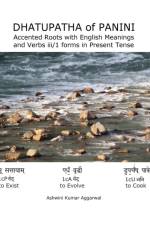- Conjugation Tables for 9 Parasmaipada 9 Atmanepada Lat LRt Lot Lang VLing RUPAS for All 1943 Dhatus. Includes Lat Karmani & Nishtha Forms
av Ashwini Kumar Aggarwal
591
This book is a seminal work on the Dhatupatha of Panini, Roots of the Sanskrit Language. It contains Sanskrit text and English commentary. It includes Accents and Meanings for each Root.Verbs are the backbone of any sentence. How may one write or understand a Sanskrit sentence without knowing the exact spelling of Verbs? This was our motive when we began writing this book.1. Verb Conjugation Tables are given for the 5 Lakaras that are prominent in literature and are in daily use in the Modern context. Lat Present Tense, LRt Future Tense, Lot Imperative Mood, Lang Past Tense, VidhiLing Potential Mood.Relevant Ashtadhyayi Sutra is indicated whenever a Dhatu is complex to conjugate. For Ubhayepadi Dhatus, both Parasmaipada and Atmanepada forms are listed.2. Additionally the Reader is introduced to the Lat Passive Voice forms for each Root.3. Nishtha Participles for each Root are also given - a kRt affix, to make the book useful and complete.4. All the Roots are listed in correct Panini order as in a standard Dhatupatha. This makes it really easy to locate any Root.5. Two Alphabetical Indexes are given, one of Dhatus-with-Tag letters, and another of Dhatus-ready-for-Conjugation. A great help for looking up hard to find Roots.6. Verb Forms for all Roots have been printed without asking the reader to refer to a previous Root. The work is in three Volumes.Vol1 Contains Roots of gana 1c to 5c, Dhatu Serial Number 1 to 1280.Vol2 Contains Roots of gana 6c to 10c, Dhatu Serial Number 1281 to 1943.Vol3 Contains Dhatupatha, KandvAdi Gana, Relevant Ashtadhyayi Sutras, Vartikas, Karikas, Sautra Dhatus, GanaSutras, Tag Letters and Indexes.The person (third person HE, second person YOU, etc.) and number (singular ONE APPLE, plural THREE APPLES, etc.) that are commonly used in English Grammar for sentence syntax, structure and meaning are Conjugated in Sanskrit within the Verb itself. This means that the person (SHE, IT, etc.) and number (BOTH ITEMS, MANY ITEMS, etc.) are not separate words in a Sanskrit sentence. The Verb in a Sanskrit sentence contains such information intrinsically. This is done by taking a Verb Stem and applying suffixes to it in a matrix of 3x3.The correct spelling of each Verb in 3 persons and numbers makes it a highly useful Edition for Grammar Schools and Vedanta Gurukuls. A must have guide for graduate and post-graduate students of Vyakarana and Sanskrit Grammar.






























